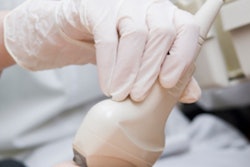
Patients should not feel unduly concerned if a dog was the previous visitor to the MRI unit, but they should worry if a bearded man has just been scanned. That's the key finding of a novel Swiss-led infection study published online by European Radiology on July 30.
Bearded men harbor significantly more microbes and human-pathogenic strains than dogs, the group found. What's more, dogs represent no risk to humans if they use the same MRI unit, although deficits in hospital hygiene continue to be a relevant risk for patients, they stated.
Around 500 million people live in Europe, compared with about 80 million dogs, but only a few veterinary clinics are equipped with dedicated animal scanners. This is largely due to the cost of medical diagnostics for animals, and it means there are too few animal scanners for the large number of sick dogs worldwide, even though many pet owners are willing to pay considerable amounts of money for diagnostics and treatment, according to the researchers.
"There are many reasons to be skeptical about examining animals in scanners intended for human use," explained lead author Dr. Andreas Gutzeit, a general radiologist at the Hirslanden Clinic in Lucerne. "One of the main reasons for this skepticism is the legitimate concern of hygiene. People are afraid they will contract a zoonosis if they share scanners with their furry friends."
Is it hygienic to share scanners?
Gutzeit and his colleagues wanted to answer this main question: Is it hygienic to evaluate dogs and humans in the same MRI machine?
To find out, they compared the bacterial load in colony-forming units (CFU) of human-pathogenic microorganisms in specimens taken from 18 bearded men and 30 dogs between July and September 2017. They also looked at the extent of bacterial contamination of an MRI scanner shared by dogs and humans with two other MRI scanners used exclusively by humans.
 Radiologist Dr. Andreas Gutzeit also has a degree in communication psychology.
Radiologist Dr. Andreas Gutzeit also has a degree in communication psychology.They sequentially examined dogs that were scheduled for a routine investigation of neurological disorders affecting the brain or spinal cord at a European hospital radiology department performing about 8,000 human MRI examinations and a variable, low number of canine MRI examinations per year.
A veterinary specialist anesthetized the dogs outside of the MRI suite. While the dogs were under anesthetic, a targeted bacteriological assay was performed in the neck of each dog between the shoulder blades.
"We examined the neck region because, according to information from the veterinarians, this is one of the few representative places on dogs that is particularly unhygienic and where most of the skin infections are encountered. This was followed by an examination of the oral mucosa in the left half of the dog's oral cavity," the authors noted. "MRI was always performed using standard surface receiver coil for the head (16-channel head coil) and the 32-channel body coil."
Following the canine radiologic examinations, standardized cleaning and disinfection of the exposed scanner were performed, after which regular MRI examinations of humans were resumed. The coils were used without protective films and had direct contact with the animals. After the cleaning and disinfection process, the bacteriological load of the MRI scanner was determined.
In addition, the researchers measured the bacteriological load of MRI scanners at two other European hospitals where only humans are examined (and never animals).
Clean dogs, dirty beards
The researchers found a significantly higher bacterial load in specimens taken from the men's beards compared with the dogs' fur (p = 0.036). All of the men showed high microbial counts, whereas only 23 out of 30 dogs had high microbial counts, and seven dogs had moderate microbial counts. Furthermore, human-pathogenic micro-organisms were more frequently found in human beards (7/18) than in dog fur (4/30), although this difference did not reach statistical significance (p = 0.074). More microbes were found in human oral cavities than in dog oral cavities (p < 0.001).
| Number of bacterial CFU in beards vs. dogs | |||
| Beard of men (%) | Fur of dogs (%) | p-value | |
| Low | 0 | 0 | 0.036 |
| Moderate | 0 | 7 (23.3) | |
| High | 18 (100) | 23 (76.7) | |
| Presence of human-pathogenic microbes | |||
| No | 11 (61.1) | 26 (86.7) | 0.074 |
| Yes | 7 (38.9) | 4 (13.3) | |
The seven human-pathogenic bacteria in the men included five cases of Enterococcus faecalis and two cases of Staphylococcus aureus. The four human-pathogenic bacteria found in the dogs coat included one case of S. aureus, two cases of Moraxella, and one case of Enterococcus.
After the MRI exams of the dogs, routine scanner disinfection was undertaken and the CFU found in specimens isolated from the MRI scanning table and receiver coils showed significantly lower bacteria count compared with "human" MRI scanners (p < 0.05).
"On the basis of these findings, dogs can be considered as 'clean' compared with bearded men," the authors wrote. "We also showed that MRI scanners and receiver coils used for clinical studies bear considerable bacterial contamination risk with human-pathogenic microbes. After dog examinations and standardized scanner disinfection, the scanners are clean and have almost no detectable remaining bacteria."
Cutting hospital infections
In the drive to reduce healthcare associated infections, arguably the central question should not be whether dogs should be allowed to undergo imaging in hospitals, but rather radiologists should focus on the knowledge and perception of hygiene and understand what poses real danger and risk to patients, they continued.
The issue of how informed hospital staff are concerning hygiene and effectiveness in reducing the specific risk is also critical. In a well-managed and hygiene-aware department, the question of whether a dog has undergone an MRI examination prior to clinical human scanning should become irrelevant, the authors believe.
They said they are not aware of any international standards for MRI hygiene, which tends to be organized individually in each hospital, and the few publications about hygiene and animals do not give clear recommendations for radiology departments.
Finally, the authors noted the limitations of their study. They only investigated the hygiene conditions of MRI scanners at three hospitals, and they cannot be certain their findings can be generalized. Also, they only examined 30 dogs and 18 bearded men, so there is a gender bias as no women were included in their study. In addition, they did not explicitly look for other micro-organisms such as worms or fleas.



.fFmgij6Hin.png?auto=compress%2Cformat&fit=crop&h=100&q=70&w=100)




.fFmgij6Hin.png?auto=compress%2Cformat&fit=crop&h=167&q=70&w=250)











